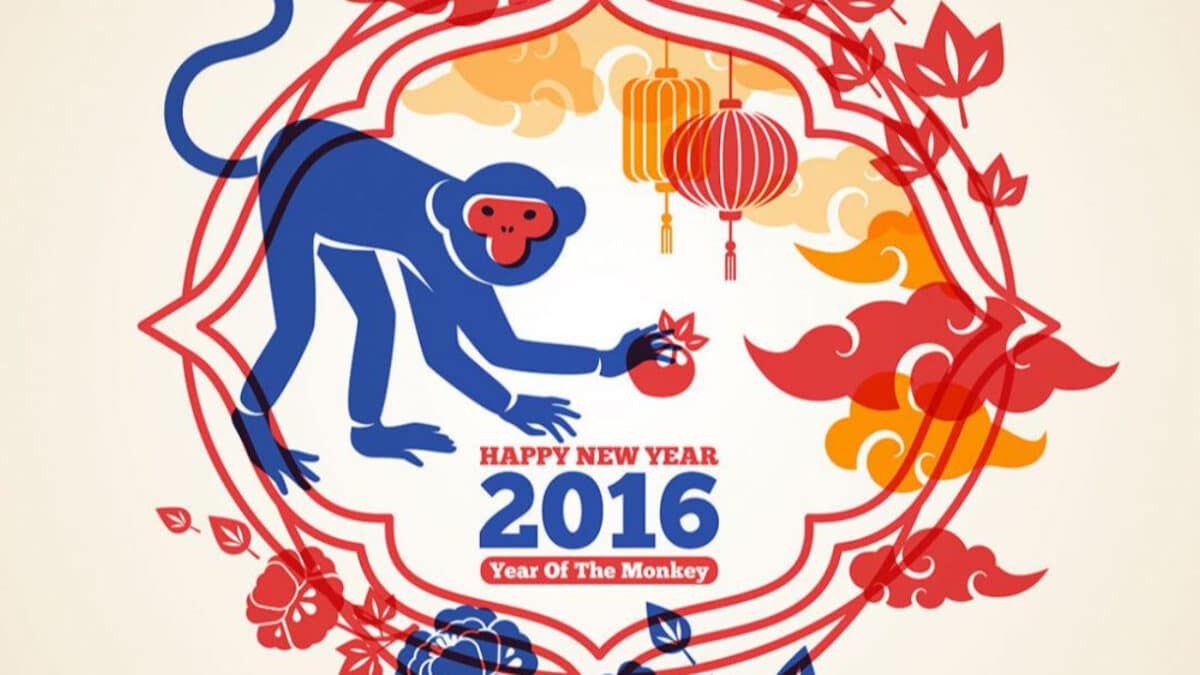Sun Leen Fai Lok and (新年快樂) and Gong hey fat choy (恭喜發財)! You must have heard these greetings repetitively in the streets of your town or city as it has already been one week since the first day of Chinese New Year. Have you ever wondered how Chinese New Year is celebrated, what customs are followed, or what the different red decorations symbolize? Below are 5 fun facts that will help you to better understand the festivities, and to get into the spirit of Chinese New Year!
1. Year of the Monkey.
In the Chinese culture, every lunar year is assigned one of 12 Zodiacs signs, each named after an animal. Monkey is the ninth animal in the 12-year cycle, and the years of the Monkey include 1920, 1932, 1944, 1956, 1968, 1980, 1992, 2004, and of course, 2016! Chinese believe that people born in a particular year take on characteristics of the animal associated with that year. People born within the Monkey sign are said to be witty, curious, sociable, and yet mischievous. So for people born within the Monkey years: Did you go monkeying around during this past week of celebrations?
2. 15-Days Celebration.
The Chinese New Year is the longest festival in the Chinese calendar, officially lasting for 15 days. You may ask, why does Chinese New Year land on different dates every year? Another name for Chinese New Year is the Lunar New Year, so dates are based on lunar and solar movements. The first official date begins with the new moon on the first day of the first lunar month, and ends on the next full moon after the 15-days cycle. During this period, family and friends will pay new year visits, also known as bai nai (拜年), to each other’s homes. In 2016, Chinese New Year is from February 8th to 22nd, ending with the Lantern Festival (元宵節). Seven more days to go!
3. Common Chinese New Year Blessings.
One of the most popular customs of Chinese New Year include greeting each other with blessings, wishes, congratulatory sayings, or however you may call it. In addition to the common “gong hey fat choy”, why not try some of the following:
- Sun tai gin hong (身體健康) – “Wishing you good health.”
- Lung ma jing sung (龍馬精神) – “Wishing you the strength of a dragon and a horse.”
- Mahn si yuh yi (萬事如意) – “May 10,000 things go according to your wishes.”
- Sum seung si sing (心想事成) – “May all of your heart’s desires come true.”
- Chut yap ping on (出入平安) – “Be safe whenever entering or exiting (e.g. home).”
In some families, children or the younger generation, must be prepared to greet their elders with a variety of these Chinese New Year sayings before they can receive red packets, also known as red envelopes, filled with various amounts of money as a symbol of happiness and blessings for the receiver.
4. Special Foods during Chinese New Year.
Chinese New Year is a time of many family-centred celebrations, as many meals are held with family and friends. Whole chicken, Chinese barbecue pork, roasted pork belly, steam fish and shrimps are must-haves for the first few days of Chinese New Year. However, the most commonly eaten food during the month of Chinese New Year is probably nian gao (年糕), literally translated as “year cake”. Prepared from simple ingredients like glutinous rice flour, wheat starch, salt, water and sugar, this dish brings tremendous blessings of the promise of a better year. Other traditional Chinese New Year snacks include deep-fried dumplings, sesame balls, tangerines and pomelo, and sugared dried fruits. For those that have yet to try out these treats, it’s the perfect opportunity right now with the celebration of Chinese New Year!
5. Chinese New Year Decorations Everywhere.
Weeks before the Lunar New Year started, Chinese homes and businesses are already decorated with many things. As you walked past Chinese supermarkets or ate in Chinese restaurants, have you ever wondered what those decorations symbolized? Here are some common decorations and their meaning:
- Red decorations: red clothing, red lanterns, red packets, red papers…as you will notice, all Chinese New Year decorations are red! This is because red is considered to be a lucky colour in the Chinese culture, as well as a symbolic colour of happiness.
- Fai chun (揮春): these are the rectangular red papers with black or gold writings of the four-character Chinese blessings as one would usually see by doorways and entrances of Chinese homes and/or businesses. Traditionally, people write these blessings in Chinese calligraphy, but in this age of technology, fai chuns are conveniently massed produced in many different styles, materials, and colours.
- Kumquat/tangerine trees: the word kum (金) means gold in Chinese, and quat (桔) sounds like good luck. Thus, having one of these trees at home symbolizes having both wealth and good luck!
By: Angel Chan, OT Reg. (Ont.)


